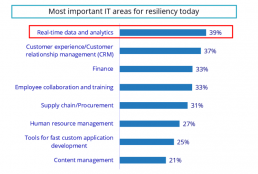Porsche is one of the world’s leading brands, signifying engineering excellence, a winning mentality, and tremendous customer loyalty. In its quest to enhance its brand and business performance, it is embracing one of the hot new techniques of data and analytics: real-time data streaming.
Sridhar Mamella, Data Streaming Manager at Porsche AG, recently spoke to IDC to explain how his team is using this technology to, as he puts it, “put a smile on our customers’ faces when they drive their Porsche.”
Data warehousing vendor Snowflake’s CEO stated at a recent European user conference that “the faster data becomes available the more useful it is.” IDC data shows that many European organizations would concur with this. Our latest European software user survey showed that, out of many important IT areas for building post-COVID resilience, real-time data and analytics was ranked number one.
But IDC understands that this is a new and potentially tricky area for many; so it’s very useful to know how Porsche, which is focused not just on engineering excellence but also cost efficiency, especially in its IT systems, has gone about building this capability.
Porsche’s aim is to exploit, in real-time where appropriate, the rapidly expanding stream of data available to its engineers from its vehicles, including behavioral data (what happens when they’re being driven) and diagnostic data (how their components perform). Modern cars have hundreds of sensors producing tens of gigabytes of potentially useful data for every hour of operation. The advent of 5G will likely accelerate real-time data capacity by orders of magnitude, as will autonomous vehicles. Benefits that can follow from using that data include improved vehicle reliability and fuel efficiency, better real-time navigation and driver assistance, and better customer service through predictive maintenance. All of these use cases, often based on AI/machine learning algorithms, are implemented through applications that rely on high volumes of accurate and recent data.
Porsche’s approach to getting that data to the applications is to create a secure, manageable, and easily accessed data pipeline between the data sources and its relevant customer and engineering applications, using a platform it has memorably dubbed Streamzilla. Originally the company exploited some proprietary (bought-in) technology but is now moving Streamzilla entirely onto open-source technology (Apache Kafka and NiFi) in the cloud, for cost, scalability, and accessibility reasons.
Streamzilla is then accessible by all teams with a data streaming need, across the organization. They can populate their data lakes, update databases, and drive their analytics applications from real-time streamed data without having to provision and manage their own Kafka/NiFi clusters. They get an enterprise-grade, scalable, and robust solution without needing open-source infrastructure management skills.
There are three key lessons from Sridhar Mamella to other organizations: that the open-source route is viable for these types of applications, as it is cost-effective and robust; that a centrally planned and deployed cloud platform is a good route to make streamed data available across a company that is even as complex, demanding, and distributed as Porsche; and that the benefits of real-time data can be made widely available to give real enterprisewide business value.
To hear Sridhar Mamella explain about implementing the Porsche Streamzilla data-streaming platform, its benefits and lessons learned, listen to this IDC TechTalk podcast.



